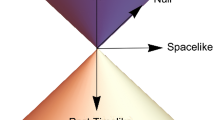Abstract
The analysis of the measurement of gravitational fields leads to the Rosenfeld inequalities. They say that, as an implication of the equivalence of the inertial and passive gravitational masses of the test body, the metric cannot be attributed to an operator that is defined in the frame of a local canonical quantum field theory. This is true for any theory containing a metric, independently of the geometric framework under consideration and the way one introduces the metric in it. Thus, to establish a local quantum field theory of gravity one has to transit to non-Riemann geometry that contains (beside or instead of the metric) other geometric quantities. From this view, we discuss a Riemann–Cartan and an affine model of gravity and show them to be promising candidates of a theory of canonical quantum gravity.
Similar content being viewed by others
REFERENCES
L. Rosenfeld, “Quanten und Gravitation,” in Entstehung, Entwicklung und Perspektiven der Einsteinschen Gravitationstheorie, H.-J. Treder, ed. (Akademie-Verlag, Berlin, 1966).
H.-H. v. Borzeszkowski and H.-J. Treder, The Meaning of Quantum Gravity (Reidel, Dordrecht, 1988).
H.-H. v. Borzeszkowski, “The Concept of Gravitons and the Measurement of Effects of Quantum Gravity,” in Quantum Gravity, Proceedings of the Third Seminar on Quantum Gravity, Moscow 1984, M. A. Markov, V. A. Berezin, and V. P. Frolov, eds. (World Scientific, Singapore, 1985).
N. Bohr and L. Rosenfeld, “Zur Frage der Meßbarkeit der elektromagnetischen Feldgrößen,” Dan. Vid. Selskab. Mat-fys. 12 (1933) No. 8. [English translation: “On the Question of the Measurability of Electromagnetic Field Quantities,” in Niels Bohr, Collected Works, Vol. 7, J. Kalckar, ed. (North-Holland, Amsterdam, 1996)].
P. A. M. Dirac, Proc. Roy. Soc. London A 167, 148 (1938).
A. O. Barut, “Nonlinear Problems in Classical and Quantum Electrodynamics,” in Nonlinear Problems in Theoretical Physics, A. F. Ranada, ed. (Springer, Berlin, 1979).
W. Pauli, “Letter to Heisenberg (18 January, 1933),” in Wolfgang Pauli, Correspondence with Bohr, Heisenberg a. o., Vol. II (1930-1933), K. v. Meyenn, ed. (Springer, Berlin, 1985).
D.-E. Liebscher, Ann. Physik (Leipzig) 30, 309, 321 (1973).
H.-H. v. Borzeszkowski and H.-J. Treder, Ann. Phys. (Leipzig) 46, 315 (1989).
H.-H. v. Borzeszkowski, V. de Sabbata, C. Sivaram, and H.-J. Treder, Found. Phys. Lett. 11, 157 (1996).
C. Rovelli and L. Smolin, Nucl. Phys. B 442, 593 (1995), Erratum, Nucl. Phys. B 456, 734 (1995).
A. Ashtekar and J. Lewandoski, Class. Quantum Grav. 14, A55 (1997); Adv. Theor. Math. Phys. 1, 388 (1997).
T. Thiemann, Class. Quantum Grav. 15, 1463 (1998); gr-qc/9705020.
T. Thiemann, “Introduction to Modern Canonical Quantum General Relativity,” Preprint AEI-2001-199, gr-qc/0110034.
V. de Sabbata, Nuovo Cimento 107A, 363 (1994).
V. de Sabbata and L. Ronchetti, Found. Phys. 29, 1099 (1999).
V. de Sabbata, L. Ronchetti, and Alfred Yu, “Torsion and Curvature as Commutator for Quantum Gravity,” in Advances in the Interplay between Quantum and Gravity Physics, P. G. Bergmann and V. de Sabbata, eds. (Kluwer Academic, Dordrecht, 2002), pp. 85–102.
F. W. Hehl, D. McCrea, E. W. Mielke, and Y. Nee'man, “Metric-affine theory of gravity: Field equations, Noether identities, world spinors, and breaking of dilation invariance,” Phys. Rep. 258, 1–171 (1995).
B. K. Datta, V. de Sabbata, and L. Ronchetti, Nuovo Cimento 113B, 711 (1998).
H. Euler and B. Kockel, Naturwiss. 23, 246 (1935). H. Euler, Ann. Phys. (Leipzig) 26, 298 (1936). W. Heisenberg and H. Euler, Z. Phys. 98, 740 (1936).
H.-H. v. Borzeszkowski and H.-J. Treder, Gen. Rel. Grav. 33, 1351 (2001).
H.-H. v. Borzeszkowski and H.-J. Treder, “Canonical Gravity and Mach's Principle: Kinematic and Dynamic Solutions of the Space Problem,” in Advances in the Interplay between Quantum and Gravity Physics, P. G. Bergmann and V. de Sabbata, eds. (Kluwer Academic, Dordrecht, 2002), pp. 57–76.
A. Einstein, “Zur allgemeinen Relativitätstheorie,” Sitz. Ber. Preuss. Akad. Wiss. Berlin 32 (1923).
E. Schrödinger, Space-Time-Structure (Cambridge University Press, Cambridge, 1950).
P. G. Bergmann, “General theory of relativity,” in Encyclopedia of Physics, Vol. 2, S. Flügge, ed. (Springer, Berlin, 1962).
H.-J. Treder, Astron. Nachr. 315, 1 (1994).
A. S. Eddington, Proc. Roy. Soc. A 99, 1040 (1921).
A. Einstein, “Zur allgemeinen Relaivitätstheorie,” Sitz.-Ber. Preuss. Akad. Wiss. Berlin, 32–38 (1923).
H.-J. Treder, Astron. Nachr. 315, 329 (1994).
Author information
Authors and Affiliations
Rights and permissions
About this article
Cite this article
Borzeszkowski, HH.v., Datta, B.K., de Sabbata, V. et al. Local and Non-Local Aspects of Quantum Gravity. Foundations of Physics 32, 1701–1716 (2002). https://doi.org/10.1023/A:1021498622495
Issue Date:
DOI: https://doi.org/10.1023/A:1021498622495




